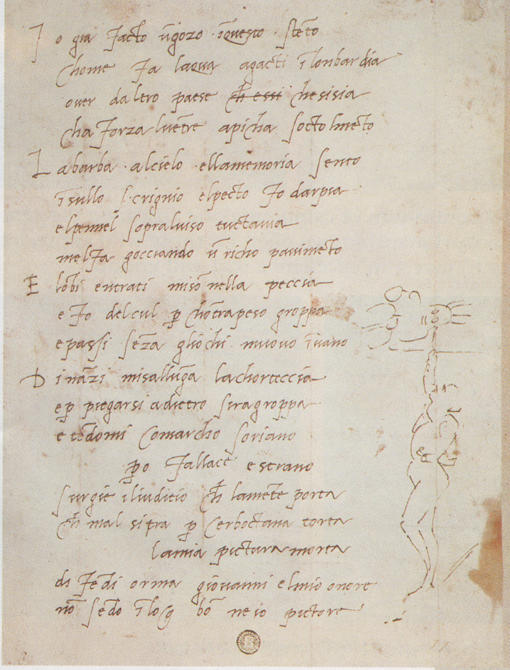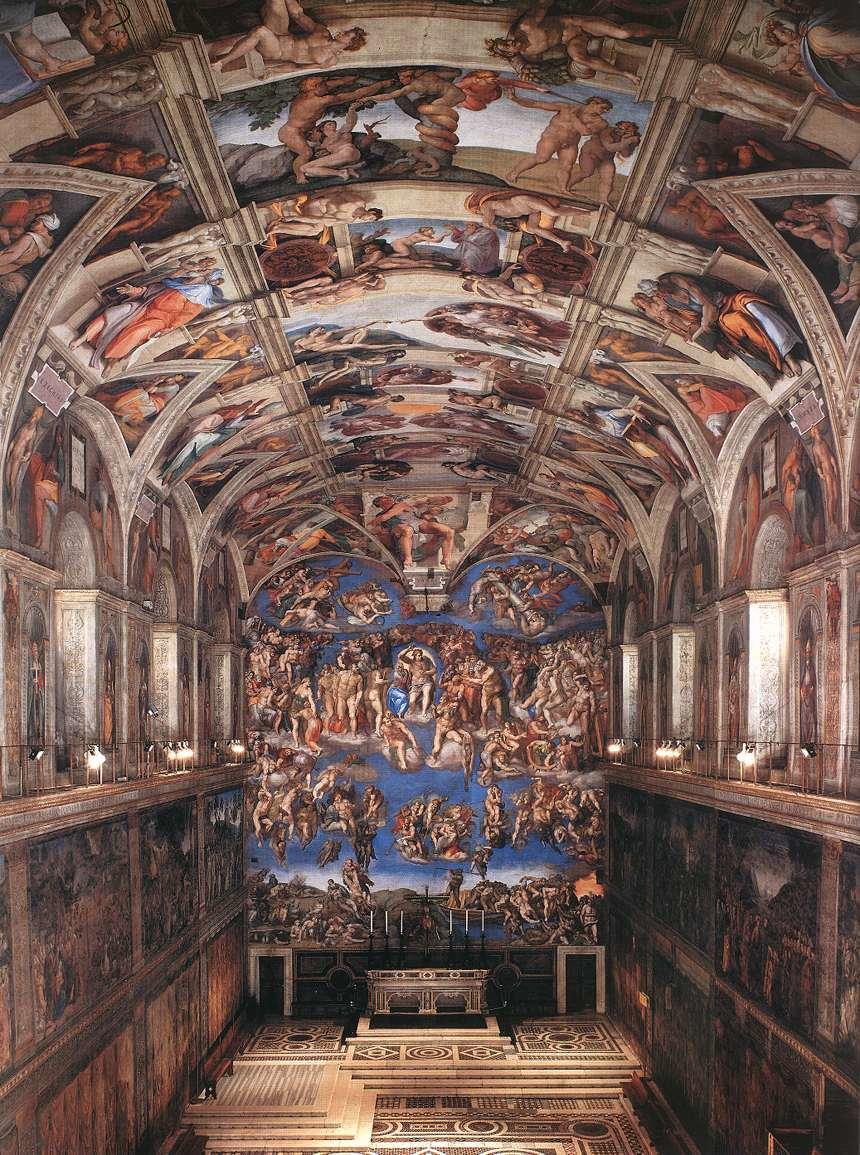Introduction
When thinking about the renaissance, one thinks about the Sistine Chapel ceiling immediately. There is no other way around. The canonic Creation of Adam seems to have become the representation of the era.
Thesis statement
Though, being inspired by the Biblical narrations and monitored by the church closely, the imagery of the Sistine Chapel ceiling was not only charged with strong Christian morals and values, but also concealed the ideas, in which Michelangelo dared venture into several ambiguous areas and point at some of the most obvious issues in Christianity.
History
In a retrospect, it is very weird to realize that what was supposed to be the symbol of Christianity and, therefore, the corresponding values, such as humbleness, humility and peacefulness was, in fact, inspired by the attempt of Pope Julius III to enhance the papal power and strengthen the influence of the Church on the civilians. Nevertheless, the fact that one of the most majestic creations of the Renaissance was built for rather dubious reasons and after quite cold calculations is true.
However, one must give credit to Julius III for allowing for some sentiment when naming the chapel after his uncle, Pope Sixtus IV (Adams 336). Michelangelo was supposed to carry out massive work, and the creation of the ceiling took quite a while. Being a sculptor and not a painter, Michelangelo was facing a real challenge.
Owing to Irving Stone’s novel, The Agony and the Ecstasy, the myth that Michelangelo painted the ceiling while lying on his back became very popular. However, as many sources point out, the reality must have been less dramatic: the artist used scaffold to adjust his position and reach the highest points of the cathedral, as well as hold his head upwards.
Despite the exhausting task of creating impeccable drawings while being in a most uncomfortable position, Michelangelo saw the situation as rather humorous and was constantly making fun of it: “I’ve already grown a goiter from this torture, /hunched up here like a cat in Lombardy” (Pinsky lines 1–2). The sketch accompanying the poem shows how exactly the paintings were created:

Narrative Framework
Though the elements of the Sistine Chapel ceiling might seem somewhat unorganized, they, in fact, create a very graphic interpretation of the Biblical stories. As it has been stressed above, the artwork features such Biblical fables as the creation of Adam and Eve, and these are not the only references to the famous fables from the Bible.
Adam’s life is shown rather precisely in a series of frescoes; likewise, the story of Noah is represented in a chronological manner. In fact, the frescoes on the Sistine Chapel ceiling can be split into four large groups, which are the story of the Creation, the Fall (the Adam and Eve story), the Story of Noah and the so-called Shields, which carry the images of minor scenes from the Old testament. The four aforementioned groups do not seem to be connected in any other way than the fact that they have all been taken from the Old Testament.
Regardless of the lack of cohesion between the four scenes, the narrative framework of each is impeccable; they render the Biblical fables in a new and unusual way. It is quite remarkable that, apart from focusing on the historical accuracy of his artwork, Michelangelo also paid great attention to depicting the emotions of the characters that he was breathing new life into.
The people were no longer the pious representations of the Biblical virtues – they experienced grief, happiness, pain, relief, anger, and the entire palette of emotions that was quite uncharacteristic for the traditional fresco style. While one must give Michelangelo credit for rendering the traditional Biblical fables in a new manner, one must also appreciate the artwork on the ceiling of the Sistine Chapel for its daring resemblance to the actual human emotions.
One of the most peculiar things about the narrative framework of the Sistine Chapel’s ceiling is the order of the frescoes, with the final one referring the viewer to the beginning of time and the creation of the Earth. To be more exact, the fresco depicts the second day of the creation, when the Day was separated from the Night.
Such an unusual yet thought provoking manner of arranging the frescoes is often interpreted as an attempt to compare the artist and God in that both are the creators: “As such, Michelangelo’s God is identified with the artist a creator of visible form” (Adams 343). Such an unusual and quite daring idea was clearly going beyond what Julius III wanted the Chapel to represent and clearly passed unnoticed by the latter.
Compositional Organization
Michelangelo doubtlessly as an architecture genius; however, claiming that the Sistine Chapel ceiling composition was unique would be quite a stretch. As a matter of fact, though doubtlessly unique, the ceiling of the Sistine Chapel was modeled after the famous Domus Area.
While the idea of following the organization of the structure, which had such an infamous end, might seem a little strange, one must admit that the result was stellar. The style of the Emperor Nero’s palace clearly matched the Pope’s intention to reinforce the influence of the Church by putting the emphasis on its glory and power, which Nero’s palace embodied.
More importantly, the introduction of the structure similar to the one of the Domus Area allowed for splitting the artwork into two major elements. Thus, the dualistic nature of the Christian religion, i.e., the contraposition of the good and the evil, was stressed with the help of the structural specifics.
This contrast, however, is also interpreted as the attempt to “juxtapose two types of predecessors” (Adams 338), i.e., the artists, who focused on Christ’s biological ancestry and those who preferred to put a stronger emphasis on the divinity of His personality. Thus, it can be argued that, splitting the ceiling of the Sistine Chapel into two structural elements, Michelangelo expressed the duality of Christ’s personality, i.e., the combination of His divine origin and His humane characteristics.

The aforementioned interpretation of the specifics of the compositional organization of the ceiling, however, is not the only alternative to the good vs. evil concept – according to Adams, a lot can be read into the symbolic duality, which Michelangelo put such a strong emphasis in his work on.
For example, the juxtaposition of prophecy and typology (Adams 339), though not as canonic as the duality of Christ’s nature, is also a very legitimate suggestion. Indeed, it would be wrong to assume that the depiction of Zacharias over the entrance and Jonah was a sporadic choice – the juxtapositions of the “human” and the “divine” aspects of the Biblical characters were too numerous to be random choices.
It is also quite remarkable that the central element of the Sistine Chapel ceiling, the creation of Eve, owes its compositional specifics entirely to the relief panels on the door of Basilica of San Petronio. For example, the scenes that are supposed to represent the Creation seem quite similar to the ones that decorate the Basilica of San Petronio (Adams 342).
However, the common elements do not make the Sistine Chapel ceiling unoriginal – instead, they help locate the specifics of the Renaissance art in general. Therefore, the compositional organization of the ceiling, though seemingly random, is, in fact, very organic. It follows very specific logics and is supposed to represent a very specific idea, and it does so in a very efficient manner.
Religious Symbolism
It would be wrong to credit Michelangelo for breaking new grounds in iconography with creating the artworks that could be interpreted in several ways. in Hiding numerous layers of meaning behind every single element covering the Sistine Chapel was, in fact, Pope Julius III’s idea. The Pope, however, seemed to have left the development of details to Michelangelo, which determined the ambiguity of the artworks.
Being free to create his own renditions of the traditional Biblical fables, as well as represent the Biblical characters in his own unique fashion, Michelangelo charged his artworks with a range of innuendoes. The aforementioned comparison between the Lord and an artist should be brought up again as a very bold move and one of the most obvious innuendoes in the fresco.
In addition, the fact that Michelangelo’s program concerning the frescoes creation was very different from the traditional prophecy-and-fulfillment typology from the very start; when beginning to work on the Sistine Chapel ceiling, the sculptor already had the concept of redemption as the basic motive for the entire artwork in his mind (Adams 336).
As a result, the paintings convey both the morals of the stories in question and the complexity of the choices made by the characters, the emotional strain and the anguish that these characters must have been going through.
While most of the religious ideas that Michelangelo placed in the corresponding context are very easy to understand, some of his renditions of the traditional Biblical plots and the elements of the Christian symbolism take quite a lot of time to be figured out. For example, the acknowledgement of the fact that in the Creation of Adam, Adam has not been born yet, since he has not touched the hand of God (Adams 343) does not come instantly to the viewer. Thus, a hidden innuendo becomes suddenly revealed, and the effect of subtlety is created. Instead of posing faith as the end in itself, which will instantly give a believer the answers to all the questions that they may have, Michelangelo makes it clear that religion should be viewed as a specific philosophy.
Conclusion
Every single element of the Sistine Chapel is clearly a masterpiece, and the ceiling, with incredible representations of the traditional Biblical fables, is truly a Renaissance miracle. While the message that the images on the Sistine Chapel ceiling send to the audience might seem clear, with a more careful analysis of the stylistic specifics of the paintings, as well as the arrangement of the frescoes, new layers of meaning will be revealed to the viewers.
Works Cited
Adams, Laurie Schneider. Italian Renaissance Art. Boulder, CO: Westview Press. 2013. Print.
Buonarotti, Michelangelo. The Sistine Chapel. 1508–1512. Web.
Michelangelo the Poet?. Web.
Pinsky, Robert. Michelangelo’s Poem about the Awkward Parturition of the Sistine Chapel. 2010. Web.